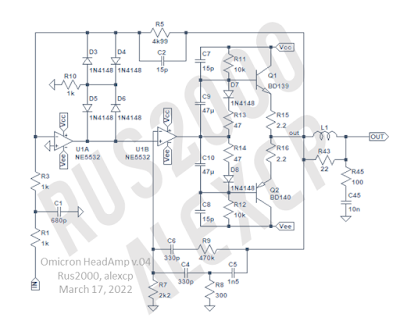This post is a part of the series on audio amplifier feedback. The contents of the series can be found here.
As discussed in my previous post on this topic, the resistive voltage divider in John D. Yewen's composite amplifier (see his article "High-precision composite op-amps" in Electronics & Wireless World, February 1987):
adds a zero to the loop gain, which helps to achieve stability at the expense of the loop gain:
For audio applications, it is desirable to maximize the loop gain, at least in the audio band, but preserve the phase margin. One way to keep that zero and maximize the loop gain at audio frequencies is to make the voltage divider frequency dependent, for example:
Adding an inductor in parallel to R3 adds a pole-zero pair (disregarding the inductor's own series resistance, the pole is at $F_p={1 \over {2 \pi}} {{R_3 || R_4} \over L_1}$, the zero at $F_z={1 \over {2 \pi}} {R_3 \over L_1}$). With the values shown, we get about 12dB of extra loop gain at 20kHz with the same phase margin as without the inductor: A 22mH inductor may not be very practical, but a similar effect can be achieved with a resistive-capacitive divider, for example:Here, the pole is at $F_p={1 \over {2 \pi R_5 (C_1 + C_2)}}$, the zero at $F_z={1 \over {2 \pi R_5 C_1}}$. With the values shown, the loop gain is about the same as with the inductor above:
Not bad for one additional passive component. It works in hardware, too - I will show a practical example in my next post.

























